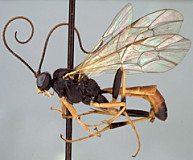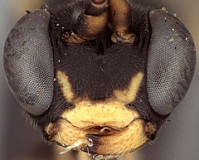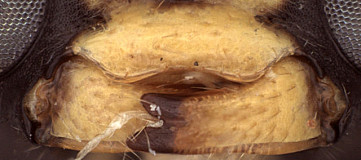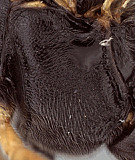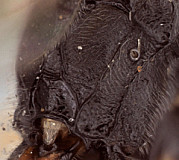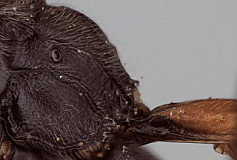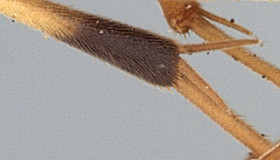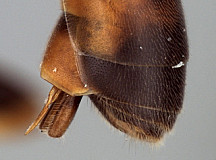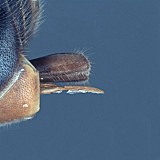Clypeus (Figs 2, 3) wide, strongly bulging subapically, with rounded transverse ridge; ventral margin sharp throughout, deeply impressed medially and occasionally difficult to see medially because of ventrally protruding median lobe of transverse ridge; ventral margin concave medially, giving bilobed appearance, with lateral margins distinctly angled dorsally; epistomal sulcus shallow but distinct. Malar space usually shorter than basal width of mandible, most commonly 0.5 times basal width of mandible or less (Fig. 2). Mandible (Fig. 3) long, curved, gradually narrowing from base to about midpoint, then parallel-sided or slightly broadened distally; ventral tooth varying from slightly to distinctly longer than dorsal tooth. Inner eye margins parallel to weakly converging ventrally. Female ocelli small, with maximum diameter of lateral ocellus usually distinctly shorter than distance between ocellus and eye. Female and male antennae equal to or longer than body; first flagellomere long and slender, nearly twice longer than second (Figs 1, 4). Hypostomal carina joining occipital carina above base of mandible; occipital carina complete. Epomia nearly always absent. Dorsal end of epicnemial carina extending to anterior margin of mesopleuron or nearly so (Fig. 5), less commonly distinctly separated from anterior margin; mesopleuron mat, with or without fine punctation. Notaulus varying from nearly absent to distinctly impressed on anterior declivity, weak to absent on disk. Pleural carina usually well-developed (Figs 6, 7), sometimes weak, especially ventroposteriorly; propodeal carinae varying from greatly reduced, nearly absent to typical mesoleiine form (Fig. 6) with sharply defined lateral longitudinal carina, hemispherical petiolar area, and parallel-sided or anteriorly converging median longitudinal carinae extending to anterior margin from petiolar area; distinct areola sometimes separated by transverse carina from basal median area. Legs with apical comb on posterior side of hind tibia short but fairly well developed, moderately dense; hind tibial spurs long, slender (Fig. 10), longest spur about as long as half length of hind basitarsus; all tarsal claws simple, not pectinate. Fore wing (Figs 1, 8) with areolet absent; stigma relatively narrow, with Rs+2r arising from or near midpoint. Hind wing with first abscissa of CU1 distinctly longer than 1cu-a. T1 (Figs 7, 11) gradually widening posteriorly; dorsal carinae usually confined to margins of deep basal depression of dorsal tendon attachment; dorsal-lateral carina usually sharp and distinct from spiracle to posterior margin of T1, sometimes poorly indicated near spiracle; glymma very deep, broad basally, narrowing posteriorly. S1 extending to level of spiracle or nearly so. Laterotergites of T2 and T3 completely separated by creases. Ovipositor (Figs 12, 13) short, weakly decurved, with deep, broad subapical, dorsal notch; ovipositor sheath shorter than hind tibial spur. Hypopygium short, with short to very short erect or somewhat anteriorly directed setae. Apex of female metasoma as in Figs 12, 13.
This description is modified from Townes (1970) and based largely on several species in the Texas A&M University Collection.

